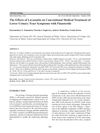TLDR Dutasteride is more effective than Finasteride in reducing prostate size and PSA levels, but both drugs have similar side effects.
The 2012 study involving 354 patients with Benign Prostatic Hyperplasia (BPH) compared the efficacy of finasteride and dutasteride, both 5-alpha reductase inhibitors. The results showed that dutasteride was more effective in reducing total prostate volume (TPV) by 28.2% and Prostate-Specific Antigen (PSA) levels by 43.6%, compared to finasteride's reduction of TPV by 20.5% and PSA by 39.2%. However, both drugs had similar side effects and there were no significant differences in quality of life score, maximal flow rate increment, or post-void residual urine reduction. The study concluded that more large-scale studies were needed to definitively compare the two drugs.
408 citations
,
May 2004 in “The Journal of clinical endocrinology and metabolism/Journal of clinical endocrinology & metabolism” Dutasteride more effectively lowers DHT levels in men with enlarged prostates than finasteride.
20 citations
,
January 2004 in “PubMed” Dutasteride reduces DHT more than finasteride, but both drugs improve BPH symptoms similarly.
 1707 citations
,
December 2003 in “The New England Journal of Medicine”
1707 citations
,
December 2003 in “The New England Journal of Medicine” Combination therapy of doxazosin and finasteride safely and effectively reduces benign prostatic hyperplasia progression risk.
 1054 citations
,
February 1998 in “The New England Journal of Medicine”
1054 citations
,
February 1998 in “The New England Journal of Medicine” Finasteride reduces urinary issues and surgery need in men with enlarged prostates by over 50%.
1 citations
,
November 2010 in “Anticancer Research” Finasteride and dutasteride both increase chromogranin A levels similarly.
 24 citations
,
October 2008 in “International Braz J Urol”
24 citations
,
October 2008 in “International Braz J Urol” Lovastatin doesn't improve lower urinary tract symptoms treatment.
 41 citations
,
June 1999 in “The Prostate”
41 citations
,
June 1999 in “The Prostate” Finasteride reduces PSA levels, terazosin doesn't affect them, and tracking prostate cancer in patients taking finasteride could be difficult.




